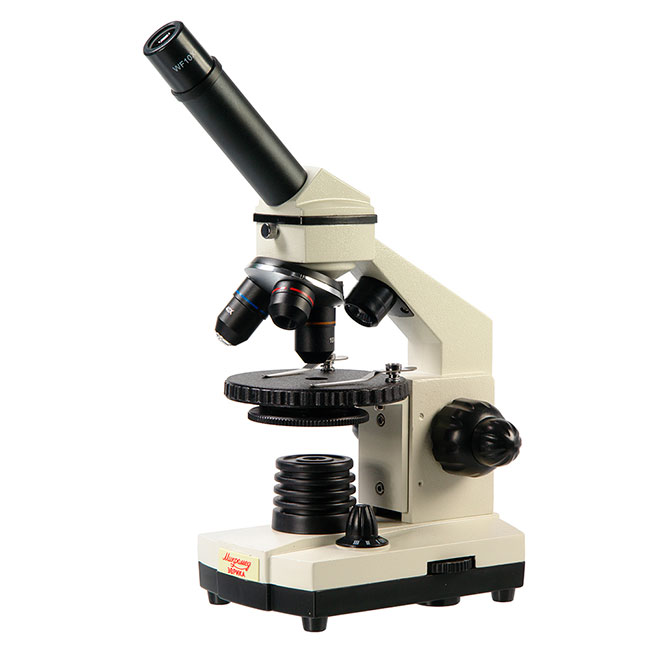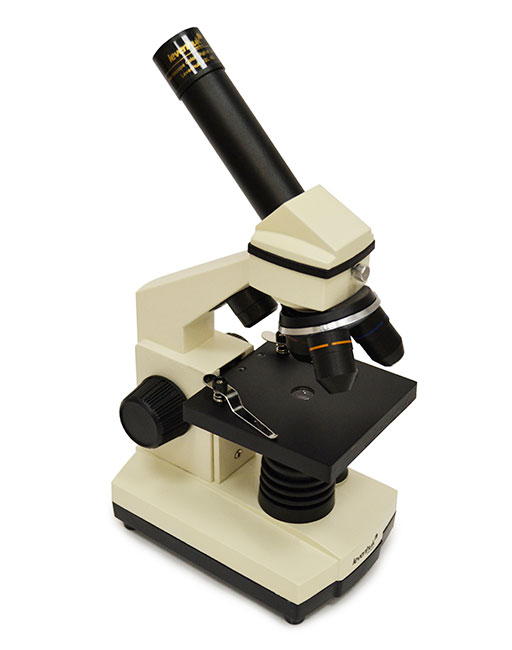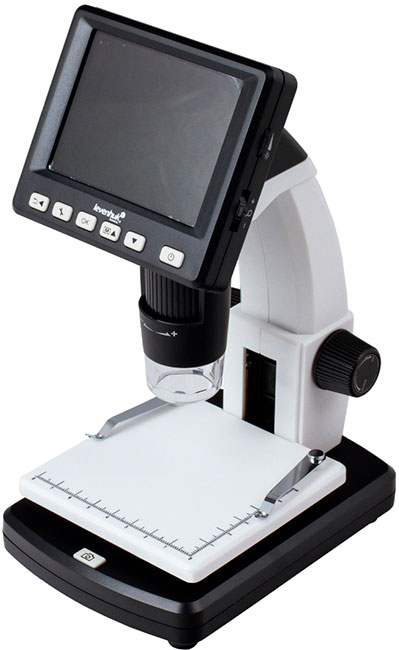Even those who consider a microscope just a toy for a child admit that this toy is useful. Having a good device, a student can plunge into an amazing nanoworld, understand how everything is arranged, and stop troubling parents with questions. In high school and specialized universities, a laboratory microscope is necessary at all. It remains to determine the range of tasks and choose the best optical device for their implementation. And our microscopes rating for schoolchildren and students will help you in this.

Content:
Microscope which company to choose
Monocular (classic) microscopes today have become more advanced: many have got built-in lights and video cameras that allow you to take pictures and take pictures while working.
The best manufacturers on the Russian market were:
1. LLC Optical Instruments (Micromed)
Initially, the Russian brand offers a wide range of optics of all levels of complexity in different price categories. The equipment is produced in factories in China, but the quality of the products remains high.
2. Levenhuk
This American manufacturer is also widely known in the Russian market. True, not original equipment from the USA comes to us, but microscopes manufactured in China under the brand. Nevertheless, it is absolutely official and decent products.
3. Bresser
The German company is known for the fact that even in the production of children's microscopes is trying to achieve maximum magnification and high-quality images. It differs from analogs in a stylish and ergonomic design.
4. Sititek
The development of equipment for this brand employs foreign and domestic specialists, and the production of ready-made models is established in China and Taiwan.
5. Sigeta
Korean brand optical devices, offering a wide range of equipment and components.
6. Sturman
Excellent optics for lovers. Most often this is a budget technique, but fortunately for its functionality did not save. Country of manufacture - China.
The best monocular microscopes for schoolchildren and students
Micromed "Eureka"

A school microscope of an average price category is able to give an approximation from 40x to 1280x. Included are three standard lenses (4x, 10x, 40x) and two mono-eyepieces with a multiplicity of 10x and 16x. In addition, there is a Barlow lens, zooming in 2 times, and a disk with filters for studying unpainted objects.
Pros:
- Suitcase for carrying;
- Camera resolution 2Mp, delivering images up to 1600x1200 px;
- Economical battery consumption;
- Tight fit eyepieces;
- Automatically save images from the camera in the program Future WinJoe;
- High quality materials and good build.
Minuses:
- At 1280x, the brightness of the images drops slightly;
- A small set of compatible software - 3 versions of Windows (XP, Vista and the "seven"), plus MAC 10.4;
- No anti-slip foot pads;
- Only coarse focus.
Buyers note a good set of tools, especially pleased with the presence of a microtome with metal knives for the preparation of sections. Useful add-ons: USB-camera, 2 LED lights (top and bottom), as well as 5 ready-to-study micro-preparations. A disk with drivers and a photo and video viewer is included.
Sturman HM1200-R

A powerful monocular microscope with magnification up to 1200x, into which even bacteria can be examined. It is completed with all necessary accessories for work (glass slides, flasks, laboratory tools).
There is even a slide with a dried butterfly, cuts of plants and insects. On a revolving attachment there are 3 lenses of different multiplicity.In addition to the maximum 120x, there is another 10x and 60x. Own increase in eyepiece 10x.
Pros:
- Good equipment and quality materials;
- High magnification;
- There is a removable projector for more comfortable working with a microscope;
- Two types of illumination - the classic mirror and diode, battery powered;
- The presence of filters.
Minuses:
- Build quality is not perfect;
- From the screen it is difficult to read the image in good light in the room, so it is better to darken the room immediately.
The manufacturer recommends this microscope for children older than 8 years, but this kind of optics is also quite suitable for students. This is a budget, but very functional device.
Levenhuk D2L NG

The model with LED backlight, which operates from the mains through a 5.5 V adapter, and from three AA batteries (all this is included). The main eyepiece is a multiplicity of 16x, lenses on the "revolver" give an increase of 4, 10 and 40x, which allows to get 640x output. It is equipped with a 0.3 MP digital camera powered via USB.
Pros:
- You can work with transparent and opaque objects;
- Large selection of recording formats (over 10);
- Compatibility with Windows of different versions: from 2000 to 8;
- The ability to process images in the program;
- Fully metal case;
- Smooth focus;
- I do not feel any backlash on moving parts;
- Comfortable lighting with adjustable.
Minuses:
- No slides;
- The camera is rather weak - it gives a resolution of images of only 640x480 px;
- The ToupView program sometimes spontaneously crashes;
- At maximum magnification and shooting through the camera, the image is dark and less detailed.
In general, a good and high-quality microscope, which is suitable for schoolchildren, but you will have to purchase tools for it.
The best binocular microscopes for schoolchildren and students
Sigeta MB-203

Biological microscope with the possibility of increasing from 40x to 1600x. It is completed with wide-field eyepieces with 10- and 16-fold approximation, as well as lenses mounted on a revolving mechanism (4, 10, 40 and 100x).
For a stereoscope, this is simply a comprehensive set. The distance between the central axes of the eyepieces is adjustable in the range of 54-75 mm.
Pros:
- Two options for focusing - coarse and thin with a small pitch (0.002 mm);
- There is a safety screw that protects the lens from contact with the table;
- Adjustable power of the built-in lighting within 6-12 W;
- Light filters for viewing transparent objects;
- Large table (130x140 mm) with fine adjustment of the position.
Minuses:
- Hard to find on sale;
- Goes in the minimum complete set - without additional toolkit.
Really versatile, though not the cheapest microscope, which is suitable for school or university. Also useful in the laboratory and when carrying out many repairs.
Levenhuk 2ST

Gives 40x magnification: 4x on the lens and 10x on each eyepiece. The stereoscope has wide control options in several parameters: 54-76 mm for interpupillary distance and from -5 to +5 for diopters on the eyepieces.
The gap between the lens and the object table is 60 mm, which allows you to explore certain small objects, like rock samples.
Pros:
- Excellent quality of materials and assembly;
- Affordable cost;
- 3-year warranty from the manufacturer;
- Bilateral subject little table with a white and black surface;
- Compatible with digital camera Levenhuk C NG (not included);
- "Friend" with the eyepieces of other manufacturers, for example, Microhoney - can be understaffed with more powerful optics with a printed dimensional grid.
Minuses:
- No focus adjustment;
- No artificial lights;
- Not very comfortable vertical position of the eyepieces.
This microscope is more suitable for research of geological samples, work with complex electronics, as well as the first optics for elementary school students who have not yet decided on their hobbies.
Micromed MS-1

A whole line of stereoscopic microscopes, produced in several versions.By selecting the magnitude of the eyepieces and the lens, you can find a model with a magnification of 10-30x or 20-40x.
Pros:
- Large working distance - 76 mm with the possibility of regulation by simply moving the case along a tripod;
- Compatible with video eyewear (purchased separately);
- Smooth approach;
- Wide view 5-10 mm;
- High-quality optics with good contrast;
- Large selection of eyepieces in the free market, allowing to obtain different magnification;
- When changing the multiplicity of focus does not get off.
Minuses:
- Eyecup is uncomfortable for some users;
- Only reflected light is used. However, in models 1C halogen lamp is built in 10 or 12 watts.
The Grenou scheme implemented in the MS, with the eyepieces at an angle, some refer to the merits of this microscope, others to disadvantages. In the first case, the assessment was influenced by high image quality, in the second - the impossibility of long-term work with such optics due to increased eye strain.
The best electron microscopes for schoolchildren and students
Levenhuk DTX 500 LCD

Here, instead of the traditional eyepieces, a 3.5-inch LCD is installed. The possibility of increasing: from 20x to 500x. The device works from the built-in battery, optics allows manual focusing up to 150 mm.
Pros:
- Photo and video can be saved to a memory card (microSD format);
- On the measuring table there is a dimension scale;
- Uniform distribution of the backlight thanks to 8 LEDs with adjustable brightness;
- It is combined with most popular software shells: Win (from XP to 10) and Mac versions 10.6-10.10;
- The ability to take pictures with a resolution of 1.3 to 12 megapixels, respectively, the photos are obtained in size from 1280x1024 to 4288x2848 px;
- Brightness and balance of colors can be easily adjusted manually on the monitor itself.
Minuses:
- The program from the installation disk starts only after the microscope is connected to the computer;
- There is no possibility to install a video ocular;
- It takes as much time to charge the battery as it takes 2 hours to work autonomously.
Buyers call this microscope the most functional and convenient. It automatically performs measurements of the parameters of the object under study and displays them on the screen.
Sititek Micron Space

Very convenient and extremely easy to use USB microscope with a magnification of 50 to 400 times. It is powered by three AA batteries, sold immediately in a hard case - for easy and safe carrying. Included is a 1.3 MP camera with connection to a computer via a USB 2.0 / 1.1 cable or to a TV (projector) via an AV cable.
Pros:
- The ability to remove the camera or the entire working unit, if you need to consider a large object that does not fit on the table;
- You can use a traditional optical eyepiece;
- Two-sided lights for studying transparent and opaque objects;
- Convenient zoom control with swivel wheel;
- Included are glasses, tools and even a sample to study, which is rare for electron microscopes.
Minuses:
- The software is installed only on Windows XP systems, 32-bit Vista and the "seven";
- Brand snow-white body.
Thanks to the ability to work on batteries, the microscope can be used "in the field." A removable camera allows you to use it to study objects of different sizes and at any angle.
Bresser Junior DM 400

An inexpensive school microscope has options for multiplicity of 20x, 80x, and 350x, as well as a 1.3 MP camera. However, it is intended only for viewing thin objects that transmit light. Included are several ready-made samples.
Pros:
- Smooth adjustment - a wheel on the case;
- There is a built-in diode backlight - powered by a computer via a USB-cable;
- Included are slides for preparing your own samples for study;
- A fairly wide range of compatible Windows software - from XP to "dozens";
- Long warranty - 5 years;
- Gives pictures with a resolution of 1280x1024 px.
Minuses:
- There is no overhead light for studying volume opaque objects;
- It works only when connected to a computer and does not imply offline use.
Which microscope to buy
1. Microscopes with high magnification are needed for laboratory work and the study of bacteria, such as Eureka Microhoney or Sturman HM1200-R.
2. If you work with a microscope for a long time, it is better to purchase a comfortable stereoscopic instrument Sigeta MB-203.
3. High school students will need only less powerful microscopes such as Levenhuk D2L NG.
4. As a gift for a child, you can choose an affordable binocular microscope with a low resolution: Levenhuk 2ST or Micromed MS-1.
5. To obtain highly accurate images of the objects under study (for preparing reports on laboratory work, course projects, etc.), you will need a good digital microscope Levenhuk DTX 500 LCD.
6. If you need to study unprepared samples outside the laboratory, it is better to take with yourself the optics Sititek Micron Space with the possibility of autonomous work.
7. For home use and preparation for schoolwork, the Bresser Junior DM 400 digital model is a good choice.
It will be interesting to friends too







